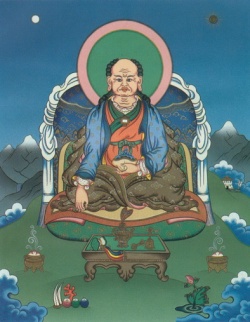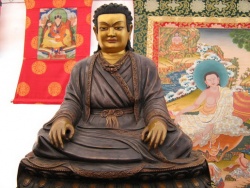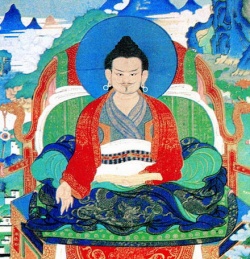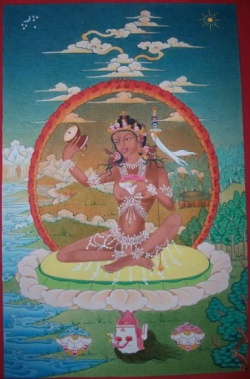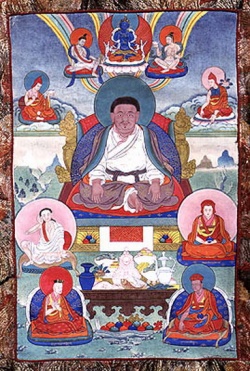Marpa Lotsawa, the translator
Marpa Lotsawa, the translator was prophetiesed by Buddha Shakyamuni and the Indian Mahasiddha Padmasambhava. He is considered a spiritual master of major importance for the establishment of Buddhism in Tibet.
Marpa was born in 1012 in Pesar, in the district of Lhotrak Chukhyer in Tibet.
From birth he was very strong of character, powerful in presence and full of energy.
At the age of 12 he entered the monastery and studied the Dharma over a period of some 15 years under the spiritual guidance of Drogmi Lotsawa, as well as Tibetan grammar, poetry, drama and Sanskrit and Hindi.
His thirst of knowledge drove him to travel three times to India at the risk of his life.
Travelling to India at that time was dangerous and full of hardships. In addition to deseases of a tropical land, gangs of bandits who knew that Tibetans in quest of Buddhism were transporting gold as offering in their luggage were threatening his life.
First journey to Nepal and India lasting 12 years
On his first trip, Marpa was accompanied by the translator Nyeu from Kharak.
They needed to get accustumed to the climate of a tropical country and therefore stayed three months in Nepal before mooving on. During this time he met the two masters Chitherpa and Paindapa, both disciples of Naropa, and received from them:
- oral instructions on ‘Sri Catuhpitha (gdan bzhi, mother tantra of the anuttara yoga)
- the pratice of Devi Vetali (du sol ma, an aspect of the protectrice Mahakali of the mandala of Hevajra).
Meeting with Naropa
The first meeting with his spiritual master Naropa took place in Pullahari (located in the present Nepal). Merely hearing the name Naropa had evoked overwhelming confidence in Marpa and gave him the determination to be without hope nor fear and in total acceptance of what was to come.
Naropa, at the sight of his disciple, greeted him with the stanza:
“In accordance with the prophecy of the Master
my son, the disciple Marpa Lodreu of extraordinary capacities
Coming from the snowy mountains of the North
you are welcome to insure your regency.”
Naropa confered upom him:
- the transmission and the empowerment of Hevajra (He expresses the joy of the transformation of sense pleasures into the union of form and emptiness),
- the transmission and empowerment of Chakrasmavara (Khor lob de mchog Wheel of Supreme Joy, mother tantra of the anuttarayoga),
- the Six Yogas (Mystical heat, illusory body, dream yoga, clear light, transfer of consciousness, and bardo: the intermediate state between death and rebirth)
- the Mahamudra of the tantras (Lhan cig skyes pa’i ye shes : direct experience of the essence of mind as being empty clarity).
During one year Marpa practised the tantra Samputa (tantra of perfect union)
In order to complete his knowledge, Naropa sent Marpa to other teachers
Jnanagarbha
From Jnanagarbha he received the transmission and empowerment of Guhyasamaja (gsang ba ‘dus pa), father tantra of the anuttarayoga, which gives the capacity to transcend anger. (Ref.Trungpa: The Life of Marpa p. 225). He also received the traditions of kriya and yoga tantra.
Kukkuripa
After having crossed a lake of poisoned, agitated water, Marpa arrived on an island of mountains, where terrible storms devastated the land. In this frightening place he met the yogi Kukkuripa who appeared to him in a human form covered with feathers.
Marpa received from him the tantra of Mahamaya and the Three yogas ( 1- the inferior yoga of the indifferentiation of appearance and form, 2- the profound yoga of the mantra, 3- the ultimate yoga of the dharma)
At the moment of his departure Kukkuripa told Marpa: “The path to meet me was very difficult. By coming here you gave deep meaning to your life.” and he prophetised that Naropa would make him his regent and that he would tame the people of the land of snow.
Maitripa
A young girl brought a vase in her hands and placed it on the his head thereby announcing to him that she was a messenger from Maitripa. He awoke full of joy. The repeatedly recurring memory of Maitripa arose in him a profound devotion. Marpa offered mentally a mandala and prayers.
At the risk of his life, without the slightest hesitation Marpa set out to meet Maitripa.With prostrations and offerings he praised Maitripa:
“…Your body is as precious as a mountain of gold,
And your wise wishes are pure.
You dispell the sickness of mental confusion
Sun of the dharma, I pay hommage to you”
Maitripa conferred upon him the transmission and oral instructions of the Mahamudra, the “Great Seal” – a spiritual path which is specific to the Karma Kagyu lineage - where all phenomena a recognized as being a symbol of the mind which is in essence clarity and emptiness.
There are three approaches of the Mahamudra: the Mahamudra of the Sutras, of the Tantras and the Essence-Mahamudra. He also transmitted
- the Aryamanjusri-nama-sangiti, an aspect of Manjushri who represents the wisdom discernment of the Buddha. He is orange in colour with three heads, black, orange, white and four arms holding a sword, a text,a bow and an arrow.
- the explanations of the dohas which are spontaneous songs of the experience and realisation of non duality. This transmission originates with Saraha.
Marpa taught them to Milarepa who used them widely for teaching purposes.
Niguma
At the shore of a poisenous lake in the south of India, in the charnel grounds of Sosadvipa, Marpa met Niguma, a wisdom dakini who was either the sister or secret consort of Naropa. She was to have a major role in the transmission lineage of the Shangpa Kagyu. She transmitted the complete empowerment and oral instructions of the Four Seats.
At that same place, Marpa received empowerments and instructions concerning the phases of generation and completion from several yogis and hermits.
Back together with Naropa
When he returned to Naropa, Marpa received very vast instructions on the Six Yogas and the Mahamudra.
Marpa put these instructions into practice and got the different signs of realisation, particularly those of the mystical heat, where he experienced a state of unconditionned bliss and clarity.
Marpa then thought about returning to Tibet in order to collect more gold for another journey to India.
At his departure, Naropa chanted these oral instructions:
“You, Marpa the translator of Tibet,
Do not allow the eight worldly occupations control your life.
Do not separate ‘myself’ and ‘other’, do not grasp at subject and object.
Do not bind yourself to friends nor to ennemies.
Do not deform the teachings of others.
Listening and contemplation are the torch which dissipates the darkness,
Do not get stuck in the sublime path that leads to liberation.
In the past we have been master and disciple
In the future, remember it well and do not deny it.”
Travelling home to Tibet
The jalousy of Nyeu
On his way back, Marpa found again his travel companion Nyeu.
Overwhelmed by jalousy at the erudition of Marpa, Nyeu bought the Indian carrier into pretending an accident thereby dumping Marpa’s books into the river Ganges. When he saw his books drowning, Marpa wanted to throw himself into the water, but the memory of his master’s instructions held him back:
“ This precious jewel of your mind,
do not through it into the water like an idiot,
but protect it from all distraction,
and your needs, desires and wishes wll be realised.”
As Marpa realised the evil intentions of his companion, he responded without hatred these verses of instruction:
“… If one is not able to do something beneficial for others,
it is still better not to cause harm.
By harming Buddha’s teachings
one is harming oneself and all other beings.
What good could that do?”
Even though Nyeu offered to lend his originals, pretending to repent his doing, Marpa turned the offer down.
In fact, as those transmissions were different, the texts were of no use. On the other hand, Marpa had through his thourough studies acquired the ability to remember the words and the deeper meaning of those texts. Once they arrived in Nepal, Marpa separated from Nyeu.
In Nepal, Marpa was warmheartedly welcomed by Chitherpa who congratulated him on his wise behaviour with Nyeu – a proof of authentic realisation. At the request of Chitherpa, Marpa began a song of the ultimate view as an expression of his own understanding:
« …The ultimate view is particular,
indivisible and without anchor,
It is the mind of the victors of the three times.
Those who desire to separate wisdom and skillful means
have to avoid falling into the two extremes.
…Compassion without reference point and
Emptiness, naked since beginningless time,
Are inseparable in the state of natural simplicity.
Understand that all things are like this.”
At the border of Nepal and Tibet, Marpa had a dream, in which he was seated on a throne. Dakinis came and carried him on the Shri Partava mountain, where he received blessing and instructions directly from master Saraha.
Saraha showed him the signs and the meaning of ultimate reality, the Mahamudra. This dream filled Marpa with enormous joy, as he was able to recall the instructions of Saraha.
Back in Tibet
All along his journey Marpa gave teachings and empowerments, thereby meeting with his first disciples Ngokteun Tcheudor, Marpa Golek and Tsourteun Wangnge.
At the age of 42, Marpa took Dagmema as his wife and they had seven sons: Darma Dode, Darma Samten, Tcheupel, Marlep, Pel Eu et Tcharik Khorlo.
In order to accomplish his practices, he also had nine secret consorts in connection with the mandala of Hevajra.
During this intermediate period between his first and second journey, Marpas parents died.
Marpa saved whatever offering was made to him, new clothing or anything of value, in order to sell them and collect the gold needed to obtain further transmissions from great Indian masters.
